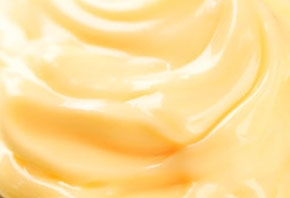The best oil for mayonnaise
Assessing the structural properties and physical stability of mayonnaises made with olive oil, with reference to its phenolic content and composition. A very detailed investigation has finally shed some light on this relatively unknown topic. We asked Professor Paola Pittia and Doctor Carla Di Mattia from the University of Teramo to describe their most recent findings, detailed in their paper "Role of olive oil phenolics in physical properties and stability of mayonnaise-like emulsions”, published in the prestigious Food Chemistry magazine

The paper written by Paola Pittia and Carla Di Mattia, from the University of Teramo, was published in issue no. 213, pages 369-370, of the prestigious scientific magazine Food Chemistry.
The purpose of the investigation was to assess the structural properties and physical stability of mayonnaises made with olive oil, in relation to their phenolic content and composition.
To this aim, mayonnaise samples were prepared using either extra virgin olive oils, which contain high levels of phenolic compounds, or purified olive oil, enriched with different amounts of either a phenolic extract obtained from olive pulp or oleuropein.
 The oils employed (a Leccino-Gentile di Chieti blend, a Coratina single varietal extra virgin and a purified olive oil) and the extract were characterised from a chemical viewpoint, determining their phenolic content and composition; the extract was then added to the purified oil, at levels that would match the phenol content in the extra virgin oils used for the trial.
The oils employed (a Leccino-Gentile di Chieti blend, a Coratina single varietal extra virgin and a purified olive oil) and the extract were characterised from a chemical viewpoint, determining their phenolic content and composition; the extract was then added to the purified oil, at levels that would match the phenol content in the extra virgin oils used for the trial.
The mayonnaises were then examined to determine the size and distribution of the oil droplets,their microstructure, textural and rheological properties. The results obtained indicate that the addition of phenolic molecules determined substantial changes in the dispersion level of the mayonnaise-like emulsions, their microstructure and physical stability, and this was particularly evident in the samples made with purified olive oil enriched with high levels of oleuropein.
 Measurements of texture and viscosity revealed that large amounts of this compound cause a poor dispersion of the fatty particles, a coarse and irregular texture of the mayonnaise and overall, an unsatisfactory consistency and firmness. These drawbacks however disappeared when a phenolic extract containing high levels of hydroxytyrosol was added to the mayonnaise samples. These findings suggest that the properties of mayonnaise not only depend on the overall content of phenols in the oil, but also on the type of molecules present.
Measurements of texture and viscosity revealed that large amounts of this compound cause a poor dispersion of the fatty particles, a coarse and irregular texture of the mayonnaise and overall, an unsatisfactory consistency and firmness. These drawbacks however disappeared when a phenolic extract containing high levels of hydroxytyrosol was added to the mayonnaise samples. These findings suggest that the properties of mayonnaise not only depend on the overall content of phenols in the oil, but also on the type of molecules present.
More in general, the research confirms the technological importance of phenolic compounds, and oleuropein in particular, their ability to affect the chemical and textural properties of emulsions, and hence, their quality and stability.
Where did you get the idea for this investigation?
For quite a few years now our research group has been investigating the technological properties of phenolic molecules in emulsified systems; many of these compounds have an amphiphilic structure, and therefore possess surface properties and interfere with the stability of the oil/water interface. If at first our interest was focused on the antioxidizing properties of the phenolic molecules present in olive oil, and how they affect emulsion-like systems, we soon realized that their effect on the physical properties of these emulsions was equally important. If present, these molecules can make it extremely difficult to disperse the oil droplets in these mayonnaise-like systems. From that moment on, we started investigating the technological properties of olive oil, exploring other complex systems such as, for instance, oleogels.
What are the practical applications of this interesting study?
The end aim of this investigation, which is included in the Doctorate research work carried out by our collaborator, Ms Veronica Giacintucci, is to characterise the technological properties of extra virgin olive oil in relation to its composition, minor compounds content and the effect of additives in making it suitable for usages other than a simple dressing ingredient. By understanding the processes behind the poor performance of olive oil in emulsion-like systems, we may find a solution to this problem, so that it can be used for a greater variety of food formulations.
In the light of these results, what message do you think we can send to the non-professional consumer?
We often hear consumers complain that extra virgin olive oil is “heavy” and therefore not suitable for any use other than dressing. An important message, in our opinion, is that the complexity of extra virgin oil certainly affects its use as an ingredient in other preparations. By studying its technological properties we could perhaps define the ideal chemical characteristics and composition an oil should have to be used in a given food matrix.
Please click HERE to be redirected to the magazine and purchase the full article.
To comment you have to register
If you're already registered you can click here to access your account
or click here to create a new account


Comment this news